

Portraits of the Disappearing Amazon By Alicia Fox. Photographer Feature!

We invite photographers to share a series of five photos with the story behind each one. We are honored to feature the work of Alicia Fox who specialises in ethical photography. With a focus on photographing people, Alicia’s work includes humanitarian photography, portraiture and sustainable fashion photography. A photographic journey with Alicia Fox The traditional tribes that dwell in the dense jungle of Peru’s Amazon region are disappearing at an alarming rate.
In 2012, I embarked on a photographic journey to document the traditional dress of these tribes – a visual representation of their traditional culture. Working with NGOs, anthropologists and locals, I was privileged to gain access to remote communities, some of which have only seen outsiders a few times in their lifetimes. Portraits of the Disappearing Amazon 1. 2. 3. 4. 5. Want More? Post By Alicia Fox. Rare photos of Angola's tribal people. Photographer Eric Lafforgue travelled to Angola and met some of the fascinating tribal peoples living thereAmong them are the Mwila whose women spend their lives wearing thick collars made from mud and beadsThey also wear ornate 'squid' hairstyles which are held in place using a mixture of ochre, cow dung and butterOther tribes include the Mucubal where women are traded for cows and men can have multiple wivesThe Muhimba, who live in the south, are related to Namibia's Himba people and share many of the same traditionsAngola recently emerged from a civil war which left people scattered and the countryside littered with land mines By Scarlett Russell and Martha Cliff Published: 11:59 GMT, 24 June 2014 | Updated: 15:10 GMT, 24 June 2014.

TRIP DOWN MEMORY LANE: February 2014. Kuba (also called Bakuba) people are agriculturalist and a cluster of Bushong-speaking ethnic groups of the larger Bantu ethnicity living in the southeastern Democratic Republic of Congo between the Kasai and Sankuru rivers east of their confluence.
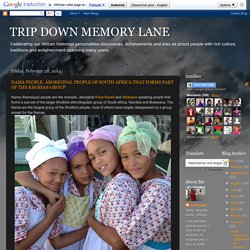
Kuba people Democratic Republic of Congo. friendsofafricaaz.org. Adivasis of India - World Directory of Minorities. Alternative names: Scheduled Tribes, various tribal names e.g.
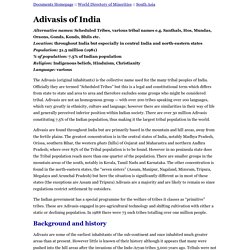
Santhals, Hos, Mundas, Oraons, Gonds, Konds, Bhils etc.Location: throughout India but especially in central India and north-eastern statesPopulation: 51.5 million (1981)% of population: 7.5% of Indian populationReligion: Indigenous beliefs, Hinduism, ChristianityLanguage: various The Adivasis (original inhabitants) is the collective name used for the many tribal peoples of India.
Officially they are termed “Scheduled Tribes” but this is a legal and constitutional term which differs from state to state and area to area and therefore excludes some groups who might be considered tribal. Adivasis are not an homogenous group — with over 200 tribes speaking over 100 languages, which vary greatly in ethnicity, culture and language; however there are similarities in their way of life and generally perceived inferior position within Indian society. Adivasi: A Contentious Term to denote Tribes as Indigenous Peoples of India. In India the term ‘Adivasi’ has gained immense popularity in the last few decades to identify the tribes.
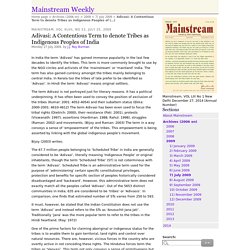
This term is more commonly brought to use by the NGO circles and activists of the ‘mainstream’ or ‘mainland’ India. The term has also gained currency amongst the tribes mainly belonging to central India. In Kerala too the tribes of late prefer to be identified as ‘Adivasi’. In Hindi the term ‘Adivasi’ means original settlers. The term Adivasi is not portrayed just for literary reasons. Bijoy (2003) writes: A Disappearing World: Robert Wallis' Adivasi captures changing India at the Brunei Gallery.
© Robert Wallis Exhibition: A Disappearing World, Brunei Gallery, London, until June 25 2011India is currently undergoing its greatest economic growth in history.
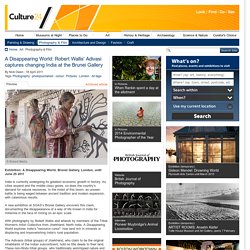
As cities expand and the middle class grows, so does the country’s demand for natural resources. In the midst of this boom, an unseen battle is being waged between ancient tradition and modern expansion, with calamitous results. A new exhibition at SOAS’s Brunei Gallery uncovers this clash, documenting the disappearance of a way of life known in India for millennia in the face of mining on an epic scale. With photography by Robert Wallis and artwork by members of the Tribal Women's Artist Collective from Jharkhand, North India, A Disappearing World explores India’s "resource curse": how land rich in minerals is displacing and impoverishing India’s rural population. Tribal & Indigenous India: Santhal Adivasi, Tribal India Lifestyle. Santhal Santhals are the largest Adivasi community in India and can be found mainly in the states of Jharkhand, Bihar, West Bengal, Madhya Pradesh, Assam, Tripura and Orissa.
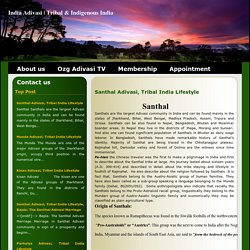
Santhals can be also found in Nepal, Bangladesh, Bhutan and Myanmar boarder areas. In Nepal they live in the districts of Jhapa, Morang and Sunsari. And also one can found significant population of Santhals in Bhutan as daily wage laborer. In Bangladesh, Santhals have made remarkable history of Santhal’s identity. Fa-hien the Chinese traveler was the first to make a pilgrimage in India and first to describe about the Santhal tribe at large. Origin of Santhals: The species known as Ramapithecus was found in the Siwalik foothills of the northwestern Himalayas. “Pro-Australoids” or “Austrics”: This group was the next to come to India after the Negritos.